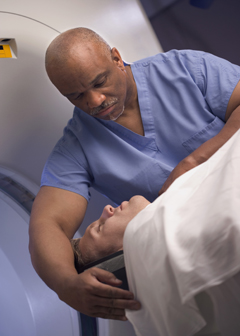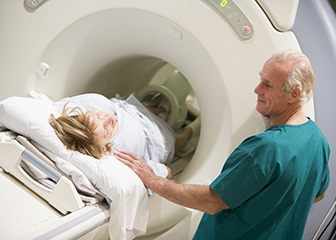How to Become a Nuclear Medicine Technologist About this section

Nuclear medicine technologists can get specialty certifications that show their proficiency in specific procedures or equipment.
Nuclear medicine technologists typically need an associate’s degree in nuclear medicine technology. Formal education programs in nuclear medicine technology or a related healthcare field lead to a certificate, an associate’s degree, or a bachelor’s degree. Technologists must be licensed in some states; requirements vary by state.
Education
Nuclear medicine technologists typically need an associate’s degree in nuclear medicine technology; there are also bachelor’s degree programs. Some technologists become qualified by completing an associate’s or a bachelor's degree program in a related health field, such as radiologic technology or nursing, and then completing a 12-month certificate program in nuclear medicine technology. Generally, certificate programs are offered in hospitals; associate's degrees in community colleges, and bachelor's degrees in 4-year colleges and universities.
Nuclear medicine technology programs include clinical experience—practice under the supervision of a certified nuclear medicine technologist and a physician who specializes in nuclear medicine. In addition, these programs often include courses in human anatomy and physiology, physics, chemistry, radioactive drugs, and computer science.
Licenses and Certification
Nuclear medicine technologists must be licensed in some states; requirements vary by state. For specifics, contact your state’s health board.
Some nuclear medicine technologists get certification. Although certification is not required for a license, it fulfills most of the requirements for state licensure on its own.
Without certification, most states require testing and have other requirements to get a license. Some employers require national certification, regardless of state regulations. Certification usually involves completing required coursework and having the necessary hours of clinical experience, as well as graduating from an accredited nuclear medicine technology program.
Certified nuclear medicine technologists must also take continuing education to keep their certification. Frequent innovations and technology changes in the field of nuclear medicine make continuing education necessary.
In addition to receiving general certification, technologists can get specialty certifications that show their proficiency in specific procedures or on certain equipment. A technologist can earn a certification in positron emission tomography (PET), nuclear cardiology (NCT), magnetic resonance imaging (MRI), or computed tomography (CT).
PET uses a machine that creates a three-dimensional image of a part of the body, such as the brain. NCT uses radioactive drugs to obtain images of the heart. Patients exercise during the imaging while the technologist creates images of the heart and blood flow. MRI uses a magnetic field to create images of an area of the body. CT uses computers to show the layers of x-ray images taken of a patient in a three-dimensional view. Each field requires the technologist to have a high level of knowledge about the specific procedures and technologies involved. The Nuclear Medicine Technology Certification Board (NMTCB) offers NCT and PET certification exams. The American Registry of Radiologic Technologists (ARRT) offers the CT and MRI certification exams.
Important Qualities
Compassion. To get the images needed for a diagnosis, nuclear medicine technologists must be able to reassure and calm patients who are under physical and emotional stress.
Detail oriented. Nuclear medicine technologists must follow exact instructions to make sure that the correct dosage is given and that the patient is not overexposed to radiation.
Interpersonal skills. Nuclear medicine technologists interact with patients and often work as part of a team. They must be able to follow instructions from a supervising physician.
Science, math, and technical skills. Nuclear medicine technologists must understand anatomy, physiology, and other sciences and be able to calculate accurate dosages. They also work with computers and large pieces of technological equipment and must be comfortable operating them.
Strength and stamina. Nuclear medicine technologists must stand for long periods and be able to lift and move patients who need help.









